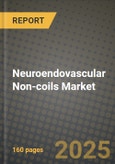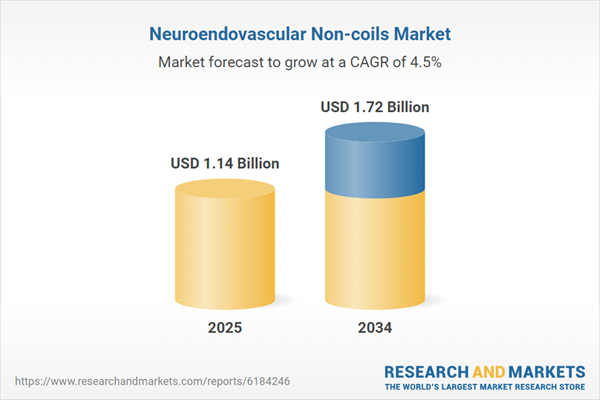Neuroendovascular Non-coils Market
The Neuroendovascular Non-coils market covers devices and tools used to treat ischemic and hemorrhagic cerebrovascular disease without detachable coils: stent retrievers, aspiration catheters and pumps, distal access and balloon guide catheters, intracranial and carotid stents, flow-diverting stents, intrasaccular flow disruptors, liquid embolics (e.g., cyanoacrylates, ethylene-vinyl alcohol copolymers), microcatheters/wires, and adjunct imaging/closure solutions. Top applications include mechanical thrombectomy for acute ischemic stroke (AIS), endoluminal reconstruction of aneurysms via flow diversion or intrasaccular devices, embolization of AVMs/AVFs, and endovascular treatment of intracranial atherosclerotic disease and cervical carotid stenosis. Trends emphasize faster, simpler reperfusion (large-bore aspiration, combined techniques), low-profile and more trackable systems for tortuous anatomy and distal/medium vessel occlusions, radial and transradial-first access, surface engineering for clot integration and anti-thrombogenicity, and AI-assisted triage to compress door-to-reperfusion time. Growth is propelled by stroke-system maturation, expanded imaging-guided time windows, broader indications (large-core, distal occlusions, ruptured/complex aneurysms), and rising neurointerventional capacity in emerging markets. Competitive dynamics pit diversified neuro majors against focused innovators; differentiation hinges on first-pass effect rates, distal navigability, lumen diameter and kink resistance, control of proximal flow with balloon guides, radiopacity, deliverability of long flow-diverter constructs, liquid embolic penetration/precison, and comprehensive portfolios that standardize trays and staff workflow. Barriers include capital and staffing for 24/7 programs, uneven reimbursement, operator learning curves, stroke triage logistics, and complication risks (hemorrhage, device migration). Overall, procurement is shifting from single devices to integrated reperfusion and aneurysm-reconstruction platforms - hardware + imaging/AI + training - validated by consistent clinical workflow and outcomes.Neuroendovascular Non-coils Market Key Insights
- Thrombectomy moves to “simple, fast, first pass”: Large-bore aspiration (direct-to-aspiration) and combined techniques (balloon guide + stent retriever) aim for higher first-pass reperfusion and fewer distal emboli; catheter trackability and column strength are make-or-break.
- Medium/distal vessel solutions emerge: Low-profile stent retrievers, flexible aspiration catheters, and micro-navigation tools extend treatment beyond ICA/M1 to M2/M3 and posterior circulation, requiring atraumatic tips and superior torque control.
- Flow diversion broadens aneurysm care: Braided, high-coverage devices with improved deliverability and anti-thrombotic surfaces expand to smaller vessels and challenging anatomies; long constructs and multi-device strategies demand precise sizing and wall apposition.
- Intrasaccular flow disruptors gain favor: WEB-like implants simplify wide-neck bifurcation aneurysms, reducing dual-antiplatelet dependency; sizing accuracy and recanalization durability differentiate offerings.
- Liquid embolics get more controllable: Lower viscosity, radiopacity tuning, and microcatheter compatibility improve AVM/AVF penetration and targeted devascularization; reliable detachment and reflux control are critical.
- Access and support define success: Balloon guide catheters for proximal flow arrest, high-support distal access catheters, and radial-ready systems reduce embolization to new territories and improve clot control.
- AI and workflow orchestration matter: LVO detection, perfusion automation, and transfer coordination compress onset-to-reperfusion and raise eligible case capture; vendors bundling software with devices influence protocol standardization.
- Safety engineering as a feature: Atraumatic tips, soft zones, heparin-like or hydrophilic coatings, and radiopaque markers reduce vessel injury and aid precise placement; robust IFUs and training curb complications.
- Economics favor platform partners: Hospitals prefer portfolios spanning aspiration, stent retrievers, flow-diverters, access, and embolics with consistent connectors, trays, and service - cutting room time and inventory.
- Talent and accreditation bottlenecks: Growth depends on training pipelines, stroke-center accreditation, and reliable 24/7 staffing; vendors with proctoring, simulation, and outcomes dashboards have an edge.
Neuroendovascular Non-coils Market Reginal Analysis
North America
Mature stroke systems drive high thrombectomy utilization with emphasis on first-pass effect, radial-ready access, and AI-enabled triage/transfer. Aneurysm programs expand flow diversion and intrasaccular devices for complex and bifurcation lesions. Procurement favors comprehensive portfolios, rapid rep support, and data-sharing that documents door-to-reperfusion metrics. Reimbursement supports 24/7 programs, but staffing and angio-suite availability remain constraints.Europe
Guideline-driven practice and cross-border referral networks emphasize evidence, cost-effectiveness, and standardized workflows. Hospitals prioritize low-profile, highly navigable systems for distal work, and flow-diverter lines with documented patency and antiplatelet management protocols. Public tenders weigh training, traceability, and sustainability (reduced kit waste). Radial access adoption grows alongside rigorous post-market surveillance.Asia-Pacific
Rapid build-out of neurointerventional centers increases demand across aspiration, stent retrievers, and flow-diversion, with strong volume growth in China, Japan, South Korea, India, and Australia. Price-performance and local service are decisive; premium hubs adopt AI triage and advanced distal systems. Training partnerships and hub-and-spoke stroke networks expand eligibility and procedural consistency.Middle East & Africa
Developing stroke networks and tertiary hubs prioritize scalable reperfusion kits, robust access catheters, and easy-to-use embolics. Procurement often seeks turnkey solutions - devices, imaging workflow, and training. Heat and logistics considerations elevate shelf-life and supply reliability. Growing interest in flow diversion and intrasaccular options accompanies investments in comprehensive neuro programs.South & Central America
Urban referral centers expand thrombectomy capacity and selective aneurysm reconstruction programs. Budget variability favors versatile, proven systems with strong local distributor support and training. Transfer logistics and imaging access drive adoption of workflow software. Institutions value platform vendors who ensure stock continuity, provide proctoring, and help track outcomes as programs scale.Neuroendovascular Non-coils Market Segmentation
By Product
- Neuroendovascular stents
- Access devices
- Flow diversion devices
- Others
By End-User
- Hospitals
- Ambulatory surgical centers
- Stroke centers
- Others
Key Market players
Medtronic Neurovascular, Stryker Neurovascular, CERENOVUS (Johnson & Johnson), Penumbra Inc., MicroVention (Terumo), Balt, Phenox (Wallaby Medical), Acandis GmbH, Rapid Medical, Imperative Care, Vesalio, MicroPort NeuroTech, Perflow Medical, Anaconda Biomed, Cerus EndovascularNeuroendovascular Non-coils Market Analytics
The report employs rigorous tools, including Porter’s Five Forces, value chain mapping, and scenario-based modelling, to assess supply-demand dynamics. Cross-sector influences from parent, derived, and substitute markets are evaluated to identify risks and opportunities. Trade and pricing analytics provide an up-to-date view of international flows, including leading exporters, importers, and regional price trends.Macroeconomic indicators, policy frameworks such as carbon pricing and energy security strategies, and evolving consumer behaviour are considered in forecasting scenarios. Recent deal flows, partnerships, and technology innovations are incorporated to assess their impact on future market performance.
Neuroendovascular Non-coils Market Competitive Intelligence
The competitive landscape is mapped through proprietary frameworks, profiling leading companies with details on business models, product portfolios, financial performance, and strategic initiatives. Key developments such as mergers & acquisitions, technology collaborations, investment inflows, and regional expansions are analyzed for their competitive impact. The report also identifies emerging players and innovative startups contributing to market disruption.Regional insights highlight the most promising investment destinations, regulatory landscapes, and evolving partnerships across energy and industrial corridors.
Countries Covered
- North America - Neuroendovascular Non-coils market data and outlook to 2034
- United States
- Canada
- Mexico
- Europe - Neuroendovascular Non-coils market data and outlook to 2034
- Germany
- United Kingdom
- France
- Italy
- Spain
- BeNeLux
- Russia
- Sweden
- Asia-Pacific - Neuroendovascular Non-coils market data and outlook to 2034
- China
- Japan
- India
- South Korea
- Australia
- Indonesia
- Malaysia
- Vietnam
- Middle East and Africa - Neuroendovascular Non-coils market data and outlook to 2034
- Saudi Arabia
- South Africa
- Iran
- UAE
- Egypt
- South and Central America - Neuroendovascular Non-coils market data and outlook to 2034
- Brazil
- Argentina
- Chile
- Peru
Research Methodology
This study combines primary inputs from industry experts across the Neuroendovascular Non-coils value chain with secondary data from associations, government publications, trade databases, and company disclosures. Proprietary modeling techniques, including data triangulation, statistical correlation, and scenario planning, are applied to deliver reliable market sizing and forecasting.Key Questions Addressed
- What is the current and forecast market size of the Neuroendovascular Non-coils industry at global, regional, and country levels?
- Which types, applications, and technologies present the highest growth potential?
- How are supply chains adapting to geopolitical and economic shocks?
- What role do policy frameworks, trade flows, and sustainability targets play in shaping demand?
- Who are the leading players, and how are their strategies evolving in the face of global uncertainty?
- Which regional “hotspots” and customer segments will outpace the market, and what go-to-market and partnership models best support entry and expansion?
- Where are the most investable opportunities - across technology roadmaps, sustainability-linked innovation, and M&A - and what is the best segment to invest over the next 3-5 years?
Your Key Takeaways from the Neuroendovascular Non-coils Market Report
- Global Neuroendovascular Non-coils market size and growth projections (CAGR), 2024-2034
- Impact of Russia-Ukraine, Israel-Palestine, and Hamas conflicts on Neuroendovascular Non-coils trade, costs, and supply chains
- Neuroendovascular Non-coils market size, share, and outlook across 5 regions and 27 countries, 2023-2034
- Neuroendovascular Non-coils market size, CAGR, and market share of key products, applications, and end-user verticals, 2023-2034
- Short- and long-term Neuroendovascular Non-coils market trends, drivers, restraints, and opportunities
- Porter’s Five Forces analysis, technological developments, and Neuroendovascular Non-coils supply chain analysis
- Neuroendovascular Non-coils trade analysis, Neuroendovascular Non-coils market price analysis, and Neuroendovascular Non-coils supply/demand dynamics
- Profiles of 5 leading companies - overview, key strategies, financials, and products
- Latest Neuroendovascular Non-coils market news and developments
Additional Support
With the purchase of this report, you will receive:- An updated PDF report and an MS Excel data workbook containing all market tables and figures for easy analysis.
- 7-day post-sale analyst support for clarifications and in-scope supplementary data, ensuring the deliverable aligns precisely with your requirements.
- Complimentary report update to incorporate the latest available data and the impact of recent market developments.
This product will be delivered within 1-3 business days.
Table of Contents
Companies Mentioned
- Medtronic Neurovascular
- Stryker Neurovascular
- CERENOVUS (Johnson & Johnson)
- Penumbra Inc.
- MicroVention (Terumo)
- Balt
- Phenox (Wallaby Medical)
- Acandis GmbH
- Rapid Medical
- Imperative Care
- Vesalio
- MicroPort NeuroTech
- Perflow Medical
- Anaconda Biomed
- Cerus Endovascular
Table Information
| Report Attribute | Details |
|---|---|
| No. of Pages | 160 |
| Published | November 2025 |
| Forecast Period | 2025 - 2034 |
| Estimated Market Value ( USD | $ 1.14 Billion |
| Forecasted Market Value ( USD | $ 1.72 Billion |
| Compound Annual Growth Rate | 4.5% |
| Regions Covered | Global |
| No. of Companies Mentioned | 15 |









